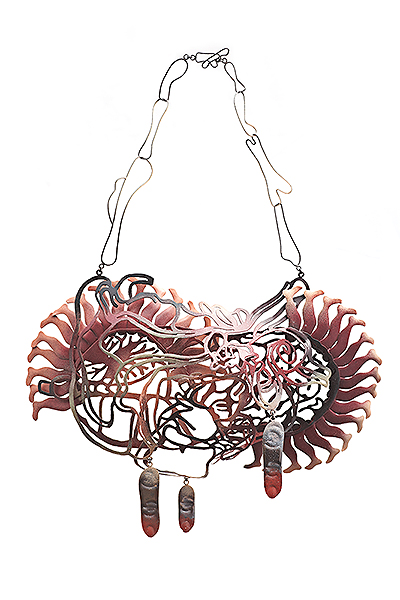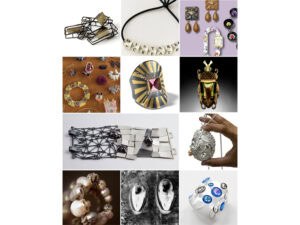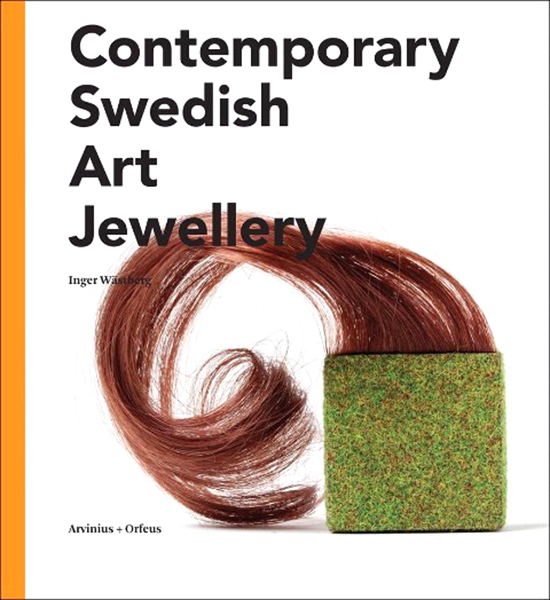 Platina gallery’s Sofia Björkman took advantage of the recent publication Contemporary Swedish Art Jewellery by Inger Wästberg to present an exhibition of pieces featured by the artists mentioned in the book. Many of these artists she already shows, and in some cases, she got to pull pieces out of the drawers to put them together in a coherent exhibit. The book features 31 Swedish jewelry artists representing work from the 1990s to today, with an introduction by Inger Wästberg and a foreword by David Revere McFadden. I asked both Inger and Sofia some questions.
Platina gallery’s Sofia Björkman took advantage of the recent publication Contemporary Swedish Art Jewellery by Inger Wästberg to present an exhibition of pieces featured by the artists mentioned in the book. Many of these artists she already shows, and in some cases, she got to pull pieces out of the drawers to put them together in a coherent exhibit. The book features 31 Swedish jewelry artists representing work from the 1990s to today, with an introduction by Inger Wästberg and a foreword by David Revere McFadden. I asked both Inger and Sofia some questions.
The artists featured are: Annika Åkerfelt, Pia Aleborg, Mike Årsjö, Anna Atterling, Yasar Aydin, Rut-Malin Barklund, Ingrid Bärndal, Sofia Björkman, Sara Borgegård, Klara Brynge, Jenny Edlund, Petronella Eriksson, Catarina Hällzon, Hanna Hedman, Karin Johansson, Agnieszka Knap, Auli Laitinen, Agnes Larsson, Hanna Liljenberg, Åsa Lockner, Märta Mattsson, Lena Olson, Annika Pettersson, Helena Sandström, Petra Schou, Aud Charlotte Ho Sook Sinding, Åsa Skogberg, Sanna Svedestedt, Tore Svensson, Mona Wallström, and Hedvig Westermark.
Questions for Inger Wastberg
Susan Cummins: Why did you become interested in collecting Swedish jewelry?
Inger Wastberg: The starting point for me was a necklace made by Mona Wallström, which I bought in 1999. That was a time of major change in my life as I had decided to join my husband, who had been appointed Consul General for Sweden in New York. The necklace served as an effective means of communication at many receptions and other events. Our role was to spread knowledge of and interest in Sweden.
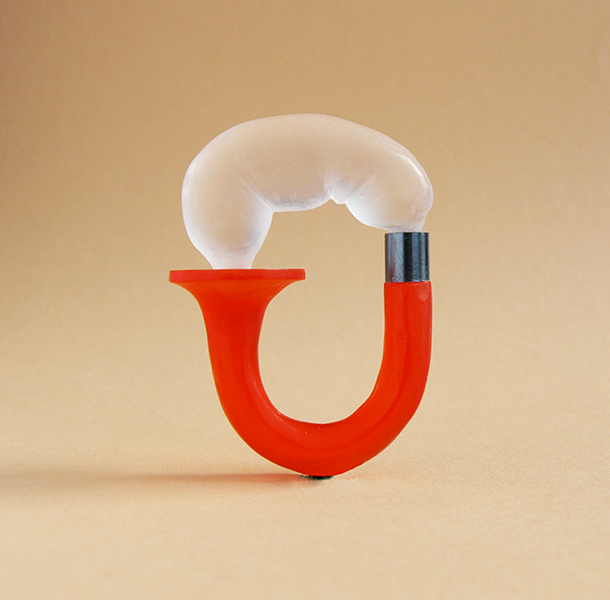
When did the idea of doing a book occur to you, and how did it come about?
Inger Wastberg: After five years in New York, I returned to Stockholm and decided to study art history. I wrote my degree paper about the collection of contemporary jewelry at our Nationalmuseum. The findings showed that the museum had neglected what happened in Gothenburg and the development of new materials and forms. The jewelry collection at the Nationalmuseum was still mainly metal and quite often geometrical. There was nothing written about Swedish jewelry after the 1980s, so I decided to write a book to share this fascinating subject with a broader audience. As a result of my paper at the university, the Nationalmuseum bought some interesting pieces by Charlotte Sinding, Åsa Skogberg, and Sofia Björkman.
Does the book feature pieces from your collection?
Inger Wastberg: Out of the 140 pieces in the book, approximately 10 are from my own collection. Obviously, the brooch I wear—Black bile by Hanna Hedman—and my first piece, the necklace made by Mona Wallström, are included. Two of my most-worn brooches Folkhemmet by Ulrica Swärd and OUT OF THE CLOSET by Auli Laitinen are included. They reflect on social and gender issues, which I have a special interest in.
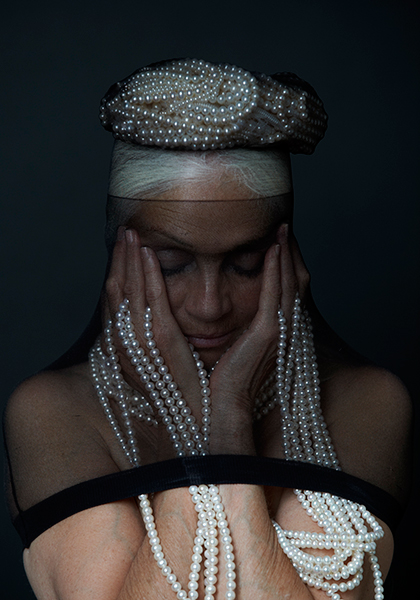
Inger Wastberg: Swedish jewelry artists work in an international context, and there are more similarities with the international trends than any typical Swedish forms or ideas. But, I have never seen gender issues being addressed at the big fairs in the way that often occurs among Swedish jewelry artists.
The tradition of working with silver remains, since Swedish Sala Silver Mine opened more than 500 years ago. Anna Atterling has found her special technique with perforated silver. Likewise Petra Schou´s little bells, Hanna Hedman´s oversize sawn and perforated pieces, Jenny Edlund´s rough enameled rings, and Åsa Lockner´s Crown Jewels all carry associations with traditional silversmithing.
Inspiration from nature is often said to be typically Swedish, but look at Van Cleef & Arpels and others.
Do you have future plans for your collection?
Inger Wastberg: I hope to be able to wear and enjoy what I have collected for some more decades. I want to keep it together and not to be split up.
Questions for Sofia Björkman
Susan Cummins: Why did you decide to have an exhibition based on the book Contemporary Swedish Art Jewellery?
Sofia Björkman: I do believe in both the written and visual language, and in combination it makes the object stronger. I have already exhibited a lot of the works in the book and some pieces I have in the gallery, so I thought it was a good opportunity to show these pieces again.
Where you able to display a number of the pieces depicted in the book?
Sofia Björkman: Yes. Of 31 artists, there is just one, Hedvig Westermark, who didn’t have one of the pieces left. Instead, I only show her new works.
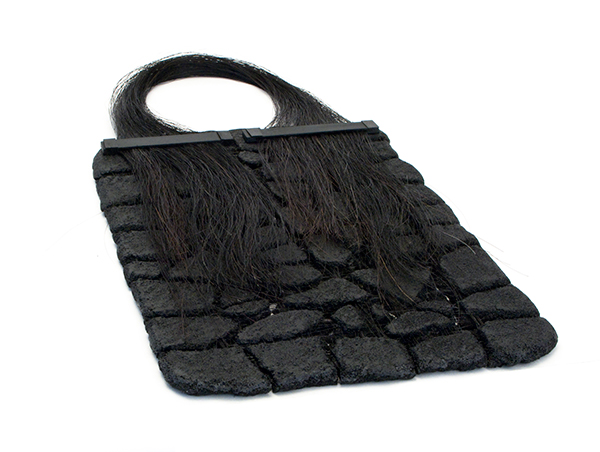
Sofia Björkman: It’s a tricky question because the world is so global now. It is also tricky to use the word Swedish. When we do so, it is, of course, important to open up for a discussion of what Swedish means. In my opinion, the most Swedish thing about this book is the cover, which features a brooch by the artist Auli Laitinen, who is working with issues of identity.
Did most of the jewelers in the book and show graduate from the Konstfack in Stockholm or the School of Design and Crafts at Gothenburg? Who are the main professors in those two schools? How do they approach teaching jewelry?
Sofia Björkman: There is a mix from both schools, and some artists have educations from schools abroad, as well. The artists have graduated from different professors. Karin Johansson is the main professor at the School of Design and Crafts at Gothenburg, and Karen Pontoppidan is at Konstfack in Stockholm. I know their artistic work, but how they approach teaching jewelry I am not sure how to answer.
How are the weather and the light in Stockholm right now? Are you doing OK?
Sofia Björkman: Thanks Susan! It’s dark and cold but beautiful. The first snow has arrived, and we are doing preparations for Christmas. Very, very busy …
Thank you.
